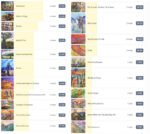The weekends are getting warmer and, although I did some painting a couple of weeks ago, I don’t think the painting season has really started until I’ve done the annual paint swatching exercise. There are some artists out there that like to do huge colour charts with all the two-colour combinations from their palette. And a 16 by 16 grid of painted squares isn’t for me. I mean, yellow plus yellow is going to make yellow, isn’t it?
So what I used to do was three mini versions of this with all the red/blue, red/yellow and yellow/blue combinations. But what’s the point of this? I like to work with three primaries on each painting. I’m not going to deviate from that just because I can perfectly match a particular secondary by deviating from my chosen three. So that’s why I’ve done something different.
I’ve looked at the eight possible combinations of my six transparent primaries. For each I’ve painted out a square with the three of them and explored the three secondary colours. Six of these already have colour key names of the (secondary, temperature) form, where I choose the two primaries closest to the secondary and then either the warm or cool version of the opposite primary. The other two are triadic colour schemes, based on equally spaced primaries rather than picking two that a4e close together. I’ve called the triadics the right and left triadics just based on how my palette’s laid out.
Right, let’s go…
Green warm. Well, there’s a grey there rather than purple but it’s nice and vibrant. The orange is more of a brown though. This one can be saved for when I need greens but not oranges or purples. I don’t actually mind it.
Purple warm features my two favourite primaries (a blue and a red). The orange is passable I guess but the green is muddy. This is one for blue, purple and yellow paintings when I want the yellow to really zing.
Orange cool. You know, I quite like the way this one hangs together. The green’s nice and understated and goes well with the reds, oranges and yellows. There’s no purple but who needs it with these colours?
Purple cool. Another long standing favourite with the ultramarine and magenta starring. I prefer this to the purple warm. The green is now much better. There’s not really an orange but the yellow and red combine to give a sort of brick red.
Triadic left. A new triad. Wow! I’m amazed by this. All three secondaries look great, despite all of them being made up of primaries that are two spaces apart. The orange and green in particular are exceptional.
Orange warm. Great oranges, reds and yellows, and obviously I like the blue. But the green and purple are both muddy. Could this be because Indian yellow and rose dore are both two pigment colours? Hmmm…
Green cool. Transplant yellow and brick red, as noted earlier, make a brick red. It’s hard to see here but the Prussian blue and magenta make a passable purple. It all sounds good but the colours feel a bit muted to me. The jury’s out on this one.
And another amazing triadic combo. These have really surprised me. This one has a great green, a great orange and a purple-grey that would make a good rainy sky. I need to give this combination a go.
At the end of this long experiment, my four favourites are the two triadics and purple and orange cools. Each primary appears in there twice, so all colours in the palette are worthy of their place. There is a pattern there, though, that I need to use a warm blue and cool yellow or vice versa. So Prussian blue with Indian yellow or French ultramarine with transparent yellow. The choice of red doesn’t matter as much. As long as I get the blue and yellow two spaces apart, I’m into one of my top four triads. This is a really valuable insight: if I ever write a book, there’s going to be a chapter on this and it will get people talking.















Leave a Reply